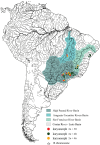Three sympatric karyomorphs in the fish Astyanax fasciatus (Teleostei, Characidae) do not seem to hybridize in natural populations
- PMID: 24260650
- PMCID: PMC3833771
- DOI: 10.3897/CompCytogen.v6i1.2151
Three sympatric karyomorphs in the fish Astyanax fasciatus (Teleostei, Characidae) do not seem to hybridize in natural populations
Abstract
Ninety individuals of the characid fish Astyanax fasciatus (Cuvier, 1819) were collected at Água da Madalena stream (Botucatu, São Paulo, Brazil) and analyzed for diploid chromosome number 2n and karyotype composition as well as for the chromosomal location of the 5S and 18S ribosomal DNA (rDNA). Whereas no chromosome differences were associated with sex, three different karyomorphs with diploid chromosome numbers 2n=46, 2n=48 and 2n=50 were found. No intermediate 2n numbers were discovered. The 2n=50 karyomorph showed some differences in 18S rDNA location compared to the two other karyomorphs. Finally, all specimens with the 2n=46 karyomorph showed the presence of a partly heterochromatic macro supernumerary chromosome, which was absent in all individuals with the two other karyomorphs. All these results suggest that indviduals of the three different karyomorphs are not likely to hybridize in the examined populations. Our findings strongly suggest the presence of three separate species (sensu biological species concept) easily diagnosed on the basis of differences in the diploid chromosome numbers and other chromosomal markers.
Keywords: B chromosome; chromosome banding; fish cytogenetics; rDNA; sympatric differentiation.
Figures


Similar articles
-
Highly Similar Morphologies Between Chromosomes Bearing U2 snRNA Gene Clusters in the Group Astyanax Baird and Girard, 1854 (Characiformes, Characidae): An Evolutionary Approach in Species with 2n = 36, 46, 48, and 50.Zebrafish. 2016 Dec;13(6):565-570. doi: 10.1089/zeb.2016.1292. Epub 2016 Jun 22. Zebrafish. 2016. PMID: 27332923
-
Karyotypic diversity among three species of the genus Astyanax (Characiformes: Characidae).Braz J Biol. 2016 Jun;76(2):360-6. doi: 10.1590/1519-6984.15414. Epub 2016 Mar 1. Braz J Biol. 2016. PMID: 26934153
-
Chromosome spreading of associated transposable elements and ribosomal DNA in the fish Erythrinus erythrinus. Implications for genome change and karyoevolution in fish.BMC Evol Biol. 2010 Sep 6;10:271. doi: 10.1186/1471-2148-10-271. BMC Evol Biol. 2010. PMID: 20815941 Free PMC article.
-
Chromosomal mapping of repetitive DNA and cytochrome C oxidase I sequence analysis reveal differentiation among sympatric samples of Astyanax fasciatus (Characiformes, Characidae).Cytogenet Genome Res. 2013;141(2-3):133-42. doi: 10.1159/000354885. Epub 2013 Sep 24. Cytogenet Genome Res. 2013. PMID: 24081020
-
Microsatellite Organization in the B Chromosome and A Chromosome Complement in Astyanax (Characiformes, Characidae) Species.Cytogenet Genome Res. 2016;148(1):44-51. doi: 10.1159/000444728. Epub 2016 Mar 19. Cytogenet Genome Res. 2016. PMID: 26992246
Cited by
-
Cytogenetics of the small-sized fish, Copeina guttata (Characiformes, Lebiasinidae): Novel insights into the karyotype differentiation of the family.PLoS One. 2019 Dec 19;14(12):e0226746. doi: 10.1371/journal.pone.0226746. eCollection 2019. PLoS One. 2019. PMID: 31856256 Free PMC article.
-
Multiple Sex Chromosomes and Evolutionary Relationships in Amazonian Catfishes: The Outstanding Model of the Genus Harttia (Siluriformes: Loricariidae).Genes (Basel). 2020 Oct 10;11(10):1179. doi: 10.3390/genes11101179. Genes (Basel). 2020. PMID: 33050411 Free PMC article.
-
First description of B chromosomes in the Hyphessobrycon (Characiformes, Characidae) genus: a hypothesis for the extra element of Hyphessobryconeques Steindachner, 1882.Comp Cytogenet. 2015 Jul 3;9(3):325-33. doi: 10.3897/CompCytogen.v9i3.5224. eCollection 2015. Comp Cytogenet. 2015. PMID: 26310656 Free PMC article.
-
Variability and evolutionary implications of repetitive DNA dynamics in genome of Astyanax scabripinnis (Teleostei, Characidae).Comp Cytogenet. 2017 Mar 6;11(1):143-162. doi: 10.3897/CompCytogen.. eCollection 2017. Comp Cytogenet. 2017. PMID: 28919955 Free PMC article.
-
Basic cytogenetics and physical mapping of ribosomal genes in four Astyanax species (Characiformes, Characidae) collected in Middle Paraná River, Iguassu National Park: considerations on taxonomy and systematics of the genus.Comp Cytogenet. 2015 Feb 9;9(1):51-65. doi: 10.3897/CompCytogen.v9i1.9002. eCollection 2015. Comp Cytogenet. 2015. PMID: 25893074 Free PMC article.
References
-
- Artoni RF, Shibatta OA, Gross MC, Schneider CH, Almeida MC, Vicari MR, Bertollo LAC. (2006) Astyanax aff. fasciatus Cuvier, 1819 (Teleostei; Characidae): evidences of a species complex in the upper rio Tibagi basin (Paraná, Brazil). Neotropical Ichthyology 4: 197-202
-
- Bakkali M, Cabrero J, López-León MD, Perfectti F, Camacho JPM. (2001) Protoplasma 217: 185-190 doi: 10.1007/BF01283399 - DOI - PubMed
-
- Bertollo LAC, Moreira-Filho O, Fontes MS. (1997) Karyotypic diversity and distribution in Hoplias malabaricus (Pisces, Erythrinidae): Cytotypes with 2n = 40 chromosomes. Brazilian Journal of Genetics 20: 237-242
-
- Cabrero J, López-León MD, Gómez R, Castro AJ, Martín-Alganza A, Camacho JPM. (1997) Geographical distribution of B chromosomes in the grasshopper Eyprepocnemis plorans along a river basin, is mainly shaped by non-selective historical events. Chromosome Research 5: 194-198 doi: 10.1023/A:1018499015091 - DOI - PubMed
-
- Cabrero J, Camacho JPM. (2008) Location and expression of ribosomal RNA genes in grasshoppers: Abundance of silent and cryptic loci. Chromosome Research 16: 595-607 doi: 10.1007/s10577-008-1214-x - DOI - PubMed
LinkOut - more resources
Full Text Sources
